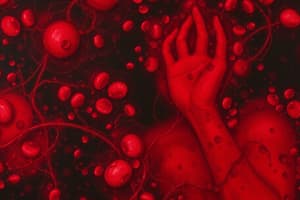Podcast
Questions and Answers
What is the normal pH range of blood?
What is the normal pH range of blood?
7.35 - 7.45
What is the term for normal blood volume?
What is the term for normal blood volume?
- HYPOVOLEMIA
- NORMOVOLEMIA (correct)
- HYPERVOLEMIA
What are the primary components of plasma?
What are the primary components of plasma?
Water, electrolytes, nutrients, gases, wastes, and proteins.
What percentage of blood volume is occupied by red blood cells (RBCs)?
What percentage of blood volume is occupied by red blood cells (RBCs)?
Lower blood volume is known as Hypervolemia.
Lower blood volume is known as Hypervolemia.
What is the role of plasma proteins in relation to colloidal osmotic pressure?
What is the role of plasma proteins in relation to colloidal osmotic pressure?
Blood accounts for approximately ______% of body mass.
Blood accounts for approximately ______% of body mass.
Which of the following functions does blood perform? (Select all that apply)
Which of the following functions does blood perform? (Select all that apply)
Match the following blood components with their functions:
Match the following blood components with their functions:
What is the primary composition of extracellular fluid (ECF)?
What is the primary composition of extracellular fluid (ECF)?
Electrophoresis is used to analyze proteins based on their charge.
Electrophoresis is used to analyze proteins based on their charge.
What is the typical volume of blood in a 70 kg male?
What is the typical volume of blood in a 70 kg male?
What is the term for lower blood volume?
What is the term for lower blood volume?
What is the term for higher blood volume?
What is the term for higher blood volume?
What percentage of blood volume is typically occupied by red blood cells?
What percentage of blood volume is typically occupied by red blood cells?
What is the normal value of hematocrit?
What is the normal value of hematocrit?
What is the major component of plasma?
What is the major component of plasma?
What proteins are primarily responsible for contributing to colloidal osmotic pressure?
What proteins are primarily responsible for contributing to colloidal osmotic pressure?
What is the role of plasma proteins in the body?
What is the role of plasma proteins in the body?
Blood primarily functions to transport oxygen and nutrients.
Blood primarily functions to transport oxygen and nutrients.
What happens if the colloidal osmotic pressure (C.O.P.) increases?
What happens if the colloidal osmotic pressure (C.O.P.) increases?
Which of the following is NOT a component of plasma?
Which of the following is NOT a component of plasma?
Which environment has a higher protein concentration: interstitial fluid (ISF) or plasma?
Which environment has a higher protein concentration: interstitial fluid (ISF) or plasma?
Which organs primarily synthesize plasma proteins?
Which organs primarily synthesize plasma proteins?
What is the role of the lymphatic system in fluid management?
What is the role of the lymphatic system in fluid management?
The percentage of blood that is extracellular fluid is approximately ___%.
The percentage of blood that is extracellular fluid is approximately ___%.
Flashcards are hidden until you start studying
Study Notes
Blood Composition
- Blood is a living tissue, part of the cardiovascular system
- It transports nutrients, respiratory gases, waste, hormones, and regulates temperature
- Blood accounts for ~7% of body mass
- Whole blood contains plasma, white blood cells, platelets, and red blood cells
Plasma
- Plasma accounts for ~55% of blood volume
- Plasma is similar to interstitial fluid (ISF)
- Plasma is mostly water (~90%) with ions, nutrients, respiratory gases, and waste products
- Plasma contains proteins, including albumins, globulins, and fibrinogen
- Albumin is the most abundant plasma protein and contributes the most to the colloidal osmotic pressure (C.O.P.)
Colloidal Osmotic Pressure
- Important in fluid balance between plasma and ISF
- Plasma proteins do not diffuse across the capillary wall, they contribute to the C.O.P.
- C.O.P. is ~25 mm Hg
Starling Forces
- Hydrostatic pressure and C.O.P. determine the movement of fluid across the capillary wall
- Filtration is the movement of fluid from capillaries to ISF, driven by hydrostatic pressure
- Osmotic flow is the movement of fluid from ISF to capillaries, driven by C.O.P.
- Excess filtered fluid is drained by the lymphatic system
Lymphatic System
- Network of vessels that collect excess fluid from ISF and return it to the bloodstream
- Lymphatic vessels are highly permeable to all ISF constituents, including proteins
- Lymphatic drainage is important for maintaining fluid balance and removing proteins from the ISF
Capillary Exchanges
- Nutrients and wastes move by diffusion
- Starling forces determine the distribution of fluid between plasma and ISF
- Filtration pushes fluid out of capillaries into ISF
- Osmotic forces pull water back into the capillaries
- Lymphatic system drains excess filtered fluid
Blood Functions
- Transportation of nutrients, respiratory gases, wastes, hormones
- Regulation of temperature
- Acid-base balance (normal pH range: 7.35 - 7.45)
- Protection through white blood cells and plasma proteins
Blood Composition
- Blood is a highly dynamic tissue, part of the cardiovascular system.
- About 7% of body mass.
- Composed of plasma, a type of extracellular fluid (ECF).
- Also contains intracellular fluid (ICF) within blood cells.
Blood Volume
- Normal blood volume is normovolemia.
- Hypovolemia describes lower than normal blood volume.
- Hypervolemia describes higher than normal blood volume.
Hematocrit
- Hematocrit (Ht) is the percentage of blood volume occupied by red blood cells.
- Normal value is approximately 45%.
- It is a useful clinical index.
Plasma Composition
- Approximately 90% water.
- Contains ions: Na+, K+, Ca++, Mg++, Cl-, HCO3-, PO4--
- Can be approximated by 0.9% NaCl physiological saline solution.
- Contains nutrients, respiratory gases, and wastes: glucose, amino acids, lipids, O2, CO2, urea, lactic acid.
- Contains proteins (colloids): Albumin, Globulins, Fibrinogen.
Plasma Protein Groups
- Albumin, globulins, and fibrinogen
- Synthesized in the liver, except for gamma globulin which originates in lymphoid tissues.
- Contribute to the colloidal osmotic pressure (C.O.P.) – also known as oncotic pressure.
- Disease of the liver results in decreased plasma protein levels.
Electrophoresis
- A fractionation method based on the movement of charged particles along a voltage gradient.
- Rate of migration is influenced by the number and distribution of charges as well as molecular weight (MW) of each protein.
- Each protein migrates at a characteristic rate.
- Serum electrophoresis is a pattern showing the presence of proteins in serum, which is plasma with fibrinogen removed.
Transcapillary Dynamics
- Refers to the exchange of fluids between capillaries and the interstitial fluid (ISF).
- The movement of molecules across the capillary wall is significantly influenced by pressure differences and the osmotic pressure.
- Pressure differences drive the movement of fluid through filtration.
- Osmotic pressure, particularly due to proteins in the blood, leads to the movement of fluid into the blood.
Starling Forces
- The major forces determining fluid movement between plasma and ISF.
- These forces are filtration and osmotic flow.
Hydrostatic Pressure
- The pressure exerted by fluids inside the capillaries.
- Tends to “push out” fluid from inside the capillaries into the ISF.
Osmotic Flow
- Generated by plasma proteins which tend to “pull in” fluid into capillaries.
Lymphatic System
- A network of vessels responsible for draining excess fluid from the ISF back into the bloodstream.
- Walls are highly permeable to all ISF constituents, including proteins.
Colloidal Osmotic Pressure (C.O.P.)
- The osmotic pressure exerted by proteins in plasma, pulling fluid into the capillaries.
- Each protein fraction exerts an osmotic pressure directly related to its concentration in the plasma and inversely related to its molecular weight.
- Albumin contributes the most to the C.O.P., due to its high concentration and relatively small size.
- The osmotic pressure of a solution depends on the number of osmotically active particles per unit volume, not their configuration, size, or charge.
Studying That Suits You
Use AI to generate personalized quizzes and flashcards to suit your learning preferences.




